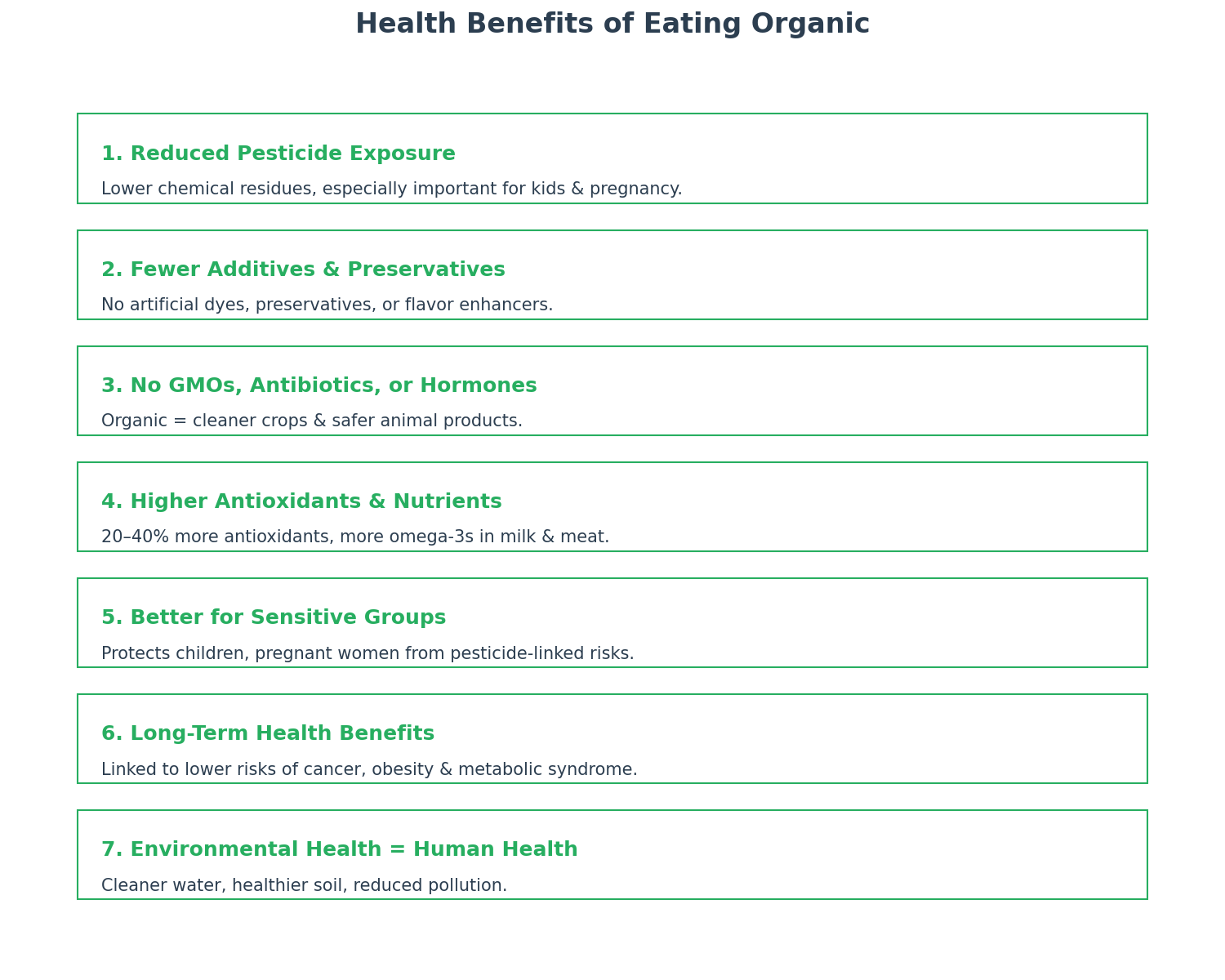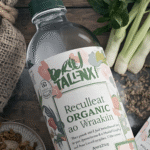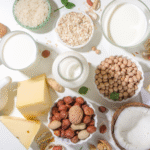From farmers’ markets to supermarket aisles, organic food has become one of the fastest-growing food categories worldwide. Shoppers are drawn to the organic label with the belief that it’s healthier, safer, and better for the planet.
But what does science really say about the health benefits of eating organic? Is it truly worth the higher price tag, or is it more about lifestyle and values?
In this complete guide, we’ll explore the research-backed health advantages of organic food — from reduced pesticide exposure to better nutrient profiles — and help you understand when choosing organic really makes a difference.
Why Health-Conscious Shoppers Choose Organic
The global demand for organic food is not just a passing trend — it’s a lifestyle shift driven by health priorities. Health-conscious consumers are increasingly selective about what they eat, and organic has become a symbol of purity, safety, and long-term wellness.
Here’s why many shoppers are willing to pay a premium for organic products:
1. Lower Chemical Exposure
- Biggest motivator: avoiding pesticides, herbicides, and synthetic fertilizers.
- Studies consistently show that organic produce has lower pesticide residues compared to conventional.
- For parents, this translates into peace of mind when feeding children, who are more vulnerable to chemical exposure.
Example: Switching to an organic diet has been shown to reduce pesticide residues in the body by up to 90% in just one week.
2. Cleaner Ingredient Lists
- Packaged organic foods must follow strict standards: no artificial colors, preservatives, or flavor enhancers.
- Health-conscious buyers like the transparency of knowing their granola bar or baby food doesn’t contain hidden chemicals.
- Shorter, cleaner labels = stronger consumer trust.
3. Higher Nutritional Value (in some cases)
- While not always dramatically different, organic crops tend to have 20–40% higher antioxidant levels, according to multiple studies.
- Organic milk and meat often contain more omega-3 fatty acids, important for heart and brain health.
- For nutrient-conscious shoppers, even small differences matter over the long term.
4. Safer Meat, Dairy, and Eggs
- Organic livestock are raised without routine antibiotics or growth hormones.
- Animals must be fed organic feed and allowed outdoor access, improving overall welfare.
- This reduces the risk of antibiotic-resistant bacteria entering the food chain and provides cleaner, more natural products.
5. Fewer Food Additives
- Organic certification bans controversial additives such as synthetic dyes, artificial sweeteners, and chemical preservatives.
- Many health-conscious consumers associate these additives with hyperactivity in children, digestive issues, or long-term health risks.
- Choosing organic helps avoid these concerns.
In short: People don’t just buy organic because it’s trendy — they do it because it offers reduced risk, cleaner food, and peace of mind for themselves and their families.
What is Organic Food? A Beginner’s Guide
Reduced Pesticide Exposure
One of the most compelling reasons people choose organic food is to minimize pesticide exposure. While conventional farming relies heavily on synthetic pesticides and herbicides to boost yields and control pests, organic farming restricts their use, relying instead on natural or non-synthetic alternatives.
What the Science Shows
- The European Food Safety Authority (EFSA, 2019) tested thousands of food samples across Europe and found that organic foods consistently had lower pesticide residues compared to conventionally grown foods.
- A U.S. study published in Environmental Research (2019) demonstrated that when children switched to an organic diet, pesticide metabolites in their urine dropped by up to 90% in just one week. This highlights how quickly dietary changes can lower exposure.
- Research compiled in the British Journal of Nutrition also confirms that organic consumers consistently have lower pesticide residues in their bodies.
Why This Matters for Health
Even though conventional foods are usually within “legal safety limits,” there is growing concern about the long-term effects of chronic low-dose exposure:
- Children and Pregnant Women at Higher Risk → Developing systems are more vulnerable to chemical interference. Pesticide exposure during pregnancy has been linked to reduced birth weight and developmental delays.
- Hormone Disruption → Some pesticides act as endocrine disruptors, potentially affecting fertility, puberty, and hormone balance.
- Cancer Links → The International Agency for Research on Cancer (IARC) has classified certain pesticides as “probably carcinogenic to humans.” Long-term dietary exposure may increase risks for cancers like non-Hodgkin lymphoma.
- Neurological Impact → Studies suggest a potential connection between pesticide exposure and neurodevelopmental disorders, including ADHD in children.
The Organic Advantage
- Organic farming prohibits synthetic pesticides and instead uses natural pest management methods such as crop rotation, predator insects, and organic-approved sprays.
- While organic food isn’t 100% pesticide-free, the residues are significantly lower and less diverse, reducing cumulative risk from multiple chemicals.
- Choosing organic for high-residue crops (like strawberries, spinach, apples, and grapes) can dramatically reduce exposure without requiring a fully organic diet.
Key takeaway: Choosing organic is one of the simplest ways to cut down on pesticide exposure, especially for children and other vulnerable groups. Even partial shifts — like going organic for the most pesticide-heavy foods — can make a measurable difference in your body’s chemical load.
The Dirty Dozen & Clean Fifteen Framework
Fewer Additives and Preservatives
Another significant health benefit of choosing organic is the absence of many artificial additives that are common in conventional processed foods. Organic certification standards go beyond farming — they also regulate how food is processed, packaged, and preserved.
Additives That Are Prohibited in Organic Foods
- Artificial Preservatives: Compounds like BHA (butylated hydroxyanisole) and BHT (butylated hydroxytoluene) are commonly used in cereals, chips, and snack foods to extend shelf life. Both are restricted in organic products because of concerns about their potential links to cancer and hormone disruption.
- Synthetic Coloring Agents: Artificial dyes like Yellow 5, Red 40, and Blue 1 are banned in organic foods. These dyes have been associated with hyperactivity in children and allergic reactions in sensitive individuals.
- Flavor Enhancers: Additives like monosodium glutamate (MSG) and artificial “smoke flavor” are not permitted. Instead, organic foods rely on natural herbs, spices, and flavoring methods.
What’s Allowed Instead
Organic packaged foods may still use some additives, but only those considered safe and natural. For example:
- Ascorbic acid (Vitamin C) — used as an antioxidant.
- Citric acid — a natural preservative derived from citrus.
- Natural enzymes and cultures — for products like cheese and yogurt.
These ingredients are generally recognized as safe and provide functionality without synthetic risks.
Why This Matters for Health
Cleaner Ingredient Lists → Organic snacks, sauces, and baby foods usually have shorter and more recognizable ingredient lists. This makes it easier for families to avoid hidden chemicals.
Children’s Health → Since kids are more sensitive to chemical additives, many parents prefer organic baby formula, snacks, and juices to minimize risks of hyperactivity, allergies, and gut irritation.
Cumulative Exposure → Even if individual additives are considered safe in small amounts, consuming multiple processed foods daily can add up to a higher cumulative load. Organic foods reduce this exposure.
The Consumer Advantage
- Parents often highlight peace of mind when choosing organic cereals, juices, and packaged snacks for their children.
- Health-conscious shoppers enjoy the “nothing artificial” promise of organic, which aligns with clean eating values.
- For people with food sensitivities, organic options reduce the risk of adverse reactions to synthetic additives.
Key takeaway: Organic packaged foods aren’t just about what’s in them — they’re also about what’s left out. By banning artificial preservatives, dyes, and enhancers, organic standards ensure that families eat cleaner, more natural food with fewer questionable chemicals.

No GMOs, Antibiotics, or Hormones
One of the defining differences between organic and conventional food is what’s not allowed. Organic certification rules prohibit genetically modified organisms (GMOs), routine antibiotics in livestock, and synthetic growth hormones. These restrictions set organic apart as a cleaner, safer choice for many consumers.
No GMOs (Genetically Modified Organisms)
What it means: GMOs are crops or animals whose DNA has been altered through genetic engineering to improve traits such as pest resistance or yield.
Organic standard: All organic crops and animal feed must be 100% GMO-free. Farmers cannot plant genetically modified seeds, and livestock cannot be fed GMO corn or soy.
Why it matters:
-
- Many consumers prefer GMO-free foods due to concerns about long-term safety and environmental impacts.
- While scientific consensus considers GMOs safe to eat, they are often tied to intensive pesticide use (like glyphosate), which raises additional health and ecological concerns.
Key takeaway: Choosing organic is the most reliable way to ensure your diet is GMO-free.
Organic vs. Non-GMO: What’s the Difference?
No Routine Antibiotics in Livestock
- Conventional farming practice: Livestock are often given routine antibiotics, even when they’re not sick, to promote faster growth and prevent disease in crowded conditions.
- Organic standard: Animals may only be treated with antibiotics if they are genuinely sick — but once treated, they can no longer be sold as organic.
- Why it matters:
- Routine antibiotic use contributes to the rise of antibiotic-resistant bacteria, recognized by the World Health Organization (WHO) as one of the greatest global health threats.
- Resistant bacteria can spread through meat, dairy, and even into the wider community, making human infections harder to treat.
- Key takeaway: Organic meat, milk, and eggs reduce exposure to antibiotic-resistant bacteria, protecting both individual and public health.
No Growth Hormones
- Conventional farming practice: Synthetic hormones such as rBGH (recombinant bovine growth hormone) may be used to increase milk production in cows or accelerate growth in beef cattle.
- Organic standard: Growth hormones are strictly prohibited. Livestock growth must occur naturally, with access to outdoor space and organic feed.
- Why it matters:
-
- Although hormone-treated foods are considered safe within regulated limits, some studies raise concerns about hormone disruption in humans and potential links to cancers.
- By banning growth hormones, organic dairy and meat give consumers peace of mind and a more natural product.
Why Consumers Care
- Parents prefer organic milk and meat for children to reduce exposure to synthetic hormones and antibiotic residues.
- Many health-conscious shoppers choose organic animal products not just for health, but also for ethical reasons — knowing that animals are raised with higher welfare standards.
- For consumers avoiding GMOs, organic offers a “one-stop solution” that guarantees GMO-free crops and livestock feed.
Key takeaway: Organic food standards eliminate GMOs, routine antibiotics, and growth hormones from the food supply. This reduces risks linked to antibiotic resistance, hormone disruption, and pesticide-heavy GMO farming — making organic a safer and more responsible choice for both families and the environment.
Higher Antioxidant and Nutrient Levels
While the nutrient content of organic vs. conventional food is often debated, several large-scale studies suggest that organic food can deliver measurable nutritional advantages. These benefits don’t come from simply being “chemical-free” but from how organic food is grown and raised.
What the Research Says
- Antioxidants in Crops:
A 2014 meta-analysis published in the British Journal of Nutrition reviewed over 300 studies and found that organic crops contained 20–40% more antioxidants than conventionally grown ones. Antioxidants such as polyphenols, flavonoids, and carotenoids are vital compounds that help the body neutralize harmful free radicals. - Omega-3s in Meat and Milk:
Research shows that organic milk and meat contain higher levels of omega-3 fatty acids, which are beneficial for heart and brain health. The difference comes from diet — organic livestock often graze on grass and forage, whereas conventional animals may be fed grain-heavy diets. - Minerals and Micronutrients:
Some studies suggest that organic produce can contain higher levels of certain minerals like iron, magnesium, and zinc, likely due to healthier soils and farming practices that replenish nutrients rather than deplete them.
Why This Matters for Health
- Chronic Disease Prevention: Antioxidants play a key role in reducing oxidative stress, which is linked to the development of cancer, cardiovascular disease, and neurodegenerative conditions like Alzheimer’s.
- Heart and Brain Health: Higher omega-3 levels in organic dairy and meat support better cardiovascular health and may improve cognitive function.
- Stronger Immune Function: Nutrient-rich foods provide the vitamins and minerals your body needs to fight infections and maintain energy levels.
Why Organic Foods May Be More Nutrient-Dense
- Healthier Soil = Healthier Crops → Organic farming emphasizes crop rotation, composting, and natural fertilizers, which improve soil fertility and enhance nutrient uptake in plants.
- No Synthetic Nitrogen Fertilizers → Conventional crops often grow faster due to synthetic fertilizers, which can dilute nutrient density. Organic crops, grown more slowly, may accumulate higher levels of beneficial compounds.
- Pasture-Based Livestock Diets → Animals raised organically spend more time grazing, which naturally boosts the omega-3 and antioxidant content of their milk and meat.
What This Means for Consumers
- Even small differences in nutrient levels can add up over time when you consider daily consumption of fruits, vegetables, milk, and meat.
- Families choosing organic milk and meat often cite the peace of mind of giving children foods with higher natural omega-3s and no synthetic additives.
- For health-conscious eaters, prioritizing organic for high-antioxidant foods like berries, leafy greens, and tomatoes can maximize nutritional benefits.
Key takeaway: Organic foods aren’t just about avoiding chemicals — they may also offer more of the good stuff, like antioxidants and omega-3s, that protect against chronic disease and support long-term wellness.
Better for Sensitive Groups (Children, Pregnant Women)
Certain groups — especially children and pregnant women — face greater risks from pesticide exposure and synthetic chemicals. Their bodies are still developing, making them more vulnerable to toxins that adults might tolerate better. For these sensitive groups, organic food offers important protections.
Why Children Are More Vulnerable
- Lower Body Weight: Children consume more food relative to their body size compared to adults, which means pesticide residues make up a larger proportion of their intake.
- Developing Systems: Their brains, nervous systems, and immune systems are still maturing, so even low levels of pesticides can disrupt normal development.
- Behavioral Impact: Some studies link pesticide exposure to attention deficit hyperactivity disorder (ADHD) and other neurodevelopmental issues.
Example: A 2010 Harvard study found a connection between organophosphate pesticide exposure and increased risk of ADHD in children.
Why Pregnant Women Should Be Cautious
- Fetal Development Risks: Exposure to pesticides during pregnancy has been associated with reduced birth weight, preterm delivery, and impaired cognitive development in children.
- Placental Transfer: Certain pesticides can cross the placenta, directly affecting the fetus during critical stages of growth.
- Long-Term Impact: Early exposure in utero may predispose children to chronic conditions later in life, such as asthma or hormonal imbalances.
Example: The CHAMACOS study (Center for the Health Assessment of Mothers and Children of Salinas) has tracked pregnant women and their children for over 20 years, linking pesticide exposure during pregnancy to lower IQ scores and developmental challenges in children.
Expert Recommendations
- The American Academy of Pediatrics (AAP) advises parents to reduce children’s exposure to pesticides by choosing organic produce for items most likely to carry residues.
- Priority foods include:
- Milk and dairy → Organic ensures no antibiotics or growth hormones.
- Fruits → Apples, pears, strawberries, and grapes are among the highest-risk (Dirty Dozen).
- Leafy greens → Spinach and kale are both nutrient-dense but pesticide-heavy in conventional farming.
Practical Advice for Families
- Focus on the Dirty Dozen → Even if you can’t buy 100% organic, prioritize organic for the most contaminated crops.
- Buy Organic Staples → Choose organic milk, eggs, and baby food to minimize risks for children.
- Frozen Counts Too → Frozen organic berries and vegetables can be more affordable while still reducing exposure.
- Mix & Match Approach → Combine organic for high-risk foods with conventional options from the Clean Fifteen list to stay within budget.
Key takeaway: For children and pregnant women, organic food provides a meaningful layer of protection. Even partial adoption — like buying organic versions of everyday staples — can reduce health risks and support safer growth and development.
Potential Long-Term Health Benefits
While day-to-day benefits like lower pesticide exposure are well documented, what matters most for many consumers is whether an organic diet can influence long-term health outcomes. Research is still evolving, but several large-scale studies suggest meaningful benefits for people who consistently eat organic.
Reduced Cancer Risk
- The NutriNet-Santé Study (France, 2018): This 70,000-person cohort study published in JAMA Internal Medicine found that individuals who ate organic foods most frequently had a 25% lower overall risk of developing cancer.
- The reductions were strongest for non-Hodgkin lymphoma (-73%) and postmenopausal breast cancer (-21%).
- Researchers attributed these results partly to lower pesticide exposure, particularly from herbicides like glyphosate, which the WHO classifies as “probably carcinogenic.”
Lower Risk of Metabolic Syndrome & Obesity
- Several observational studies suggest that organic food consumers have lower BMI (Body Mass Index) and reduced risk of obesity-related conditions.
- A review in Nutrients (2020) linked organic diets to lower incidence of metabolic syndrome, a cluster of conditions that increase risk for diabetes, heart disease, and stroke.
- While lifestyle factors (like exercise and general health-conscious behavior) may also play a role, the evidence suggests that organic diets may support better weight management and metabolic health.
Cardiovascular & Neurological Protection
- Organic foods often have higher antioxidant and omega-3 levels, which play a role in reducing oxidative stress and inflammation.
- Over time, this could lower the risk of cardiovascular disease and support brain health, potentially reducing risks of neurodegenerative diseases like Alzheimer’s.
Lifelong Impact of Early Exposure
- Studies indicate that pesticide exposure during pregnancy or childhood can have lasting effects, increasing risk for chronic diseases later in life.
- By reducing pesticide intake early in life, organic diets may provide a form of “health insurance” against long-term conditions that develop over decades.
The Evidence Gap
- It’s important to note that while the evidence is promising, long-term randomized controlled trials are still limited.
- Many findings come from observational studies, which can’t prove causation but do highlight strong associations.
- Still, the consistency of findings across cancer, metabolic health, and child development makes a compelling case for choosing organic when possible.
Key takeaway: While organic food isn’t a guaranteed shield against disease, current research suggests it can lower the risk of certain cancers, obesity, and metabolic conditions. Choosing organic — especially over the long term — may offer protective benefits that go beyond nutrition, influencing lifelong health outcomes.
Indirect Health Benefits Through Environment
When people think of organic food, they often focus only on what’s on their plate — fewer pesticides, no GMOs, and cleaner ingredients. But one of the biggest health advantages of organic farming comes indirectly, through its positive impact on the environment. Healthy ecosystems lead to healthier people, because our air, water, and soil form the foundation of the food chain.
Cleaner Water
- Conventional farming often relies on synthetic fertilizers and pesticides that run off into rivers, lakes, and groundwater. This runoff contributes to nitrate contamination, which has been linked to health issues such as thyroid disease and certain cancers.
- Organic farming avoids these chemicals, leading to less contamination of drinking water sources. Communities near organic farms benefit from safer, cleaner water supplies.
Healthier Soils, Healthier Food
- Organic farming emphasizes soil fertility through composting, crop rotation, and natural fertilizers. This builds soils rich in organic matter and nutrients.
- Healthier soils store more carbon and retain more water, making farms more resilient to drought and climate change.
- Nutrient-rich soil also produces nutrient-dense crops, supporting stronger human nutrition over the long term.
Reduced Air Pollution
- Synthetic nitrogen fertilizers release nitrous oxide, a greenhouse gas nearly 300 times more potent than carbon dioxide. They also contribute to smog and respiratory problems in farming regions.
- By avoiding synthetic fertilizers, organic farms reduce air pollution, improving community respiratory health and lowering contributions to climate change.
Protecting Pollinators & Biodiversity
- Conventional pesticide use has devastated pollinator populations, including bees and butterflies, which are critical to food security.
- Organic farming supports biodiversity by providing habitats and avoiding harmful chemicals.
- Stronger ecosystems = more resilient food supply chains = healthier long-term diets for humans.
Human Health Tied to Environmental Health
The connection is simple but profound:
- Polluted water → unsafe to drink
- Degraded soil → less nutritious crops
- Air pollution → respiratory disease
- Loss of biodiversity → weaker food systems
By protecting natural resources, organic farming creates healthier conditions for human communities now and for generations to come.
Key takeaway: Organic farming isn’t just about personal health — it’s about protecting the shared environment that sustains all human life. Every organic choice is a vote for cleaner water, healthier soils, and a safer climate, all of which circle back to support human health.
Practical Tips: When to Prioritize Organic
Since going 100% organic can be expensive, focus on high-impact swaps:
- Go Organic For:
- Dirty Dozen fruits and veggies (strawberries, spinach, apples, etc.)
- Dairy products
- Meat and poultry
- Children’s staple foods
- Safe to Buy Conventional:
- Clean Fifteen produce (avocados, onions, sweet corn, etc.)
- Packaged foods with little/no risk of pesticide residues
Frequently Asked Questions (FAQ)
1. Is organic food always healthier?
Not always. Nutrients can be similar, but organics reduce pesticide exposure and avoid additives, making them a safer choice in many cases.
2. Are organic foods worth the higher cost?
Yes, especially for children’s staples and high-risk produce. For other items, using the Dirty Dozen/Clean Fifteen framework can help balance cost.
3. Does organic food taste better?
Often, but not always. Taste depends on freshness and variety as much as farming practices.
4. Can I eat healthier without going fully organic?
Absolutely. A diet rich in whole foods, fruits, and vegetables — whether organic or conventional — is healthier than a processed diet.
Conclusion
The health benefits of eating organic go beyond just avoiding chemicals. From lower pesticide residues and cleaner ingredients to potentially higher antioxidants and omega-3s, organic food offers tangible advantages — especially for children, pregnant women, and families concerned about long-term wellness.
That said, organic food isn’t a magic bullet. The smartest approach is balance: prioritize organic where it matters most, mix in non-GMO or conventional where safe, and focus on an overall diet rich in whole, minimally processed foods.










